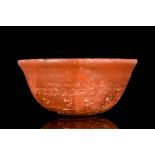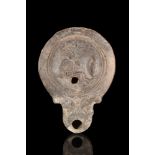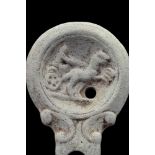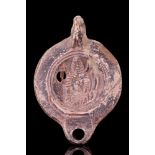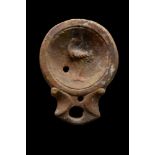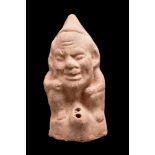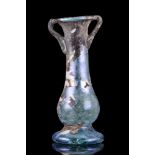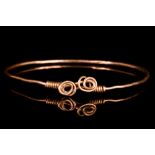Verfeinern Sie Ihre Suche
Schätzpreis
Kategorie
- Jewellery (92)
- Greek, Roman, Egyptian & Other Antiquities (85)
- Arms, Armour & Militaria (56)
- Sculpture (41)
- Ceramics (39)
- Coins (37)
- Chinese Works of Art (28)
- Glassware (25)
- Books & Periodicals (16)
- Salvage & Architectural Antiques (14)
- Porcelain (13)
- Collectables (9)
- Taxidermy & Natural History (6)
- Vintage Fashion (6)
- Classic Cars, Motorcycles & Automobilia (4)
- Furniture (4)
- Metalware (4)
- Textiles (4)
- Lighting (2)
- Islamic Works of Art (1)
- Musical Instruments & Memorabilia (1)
- Oil, Acrylic paintings & Mixed Media (1)
- Scientific Instruments (1)
- Stamps (1)
- Tools (1)
- Liste
- Galerie
Ein Abonnement der Preisliste ist notwendig um Ergebnisse, von Auktionen die vor einem längeren Zeitraum als 10 Tagen stattgefunden haben, ansehen zu können. Klicken Sie hier für mehr Informationen
Ca. 100-300 AD. A rare set of five Roman surgical tools composed of a double-ended fork, spoon, spatula, and probes. Each tool with a long, round ...
ROMAN SILVER COCHLEAR SPOON
Ca. 100-300 AD. A solid silver spoon with a wide bowl attached to a long round-section handle finished with a pointed finial for use in extracting...
ROMAN SILVER BOWL
Ca. 100-300 AD. An outstanding silver bowl with a slightly rounded base, straight rim and a broad, deep body. Bowls of this kind were used for pou...
ROMAN SILVER BOWL
Ca.100-300 AD. A silver wine bowl with a hemispherical body and smooth walls. Banqueting was a major part of the aristocratic culture in antiquity...
Ca. 1200-800 BC. A hammered-bronze vessel of a wide, circular form with its walls gently tapering to a flat base. The mid-section is adorned with ...
Ca. 300-400 AD. A wheel-thrown redware pottery dish of a squat form that rests atop a flat base. The vessel features broad walls, a shallow basin,...
Ca. 300-400 AD. A large terracotta shallow plate or dish with its walls gently tapering to a low ring base. Between the rim and basin, there is a ...
Ca. 300-400 AD. A fine redware jug, with a rounded body and applied decoration including a youthful Bacchus drinking from a wine cup, and four pal...
Circa 300 – 200 AD . A pottery vessel in the form of a jug with a bulbous shaped body decorated with indented imprints. The vessel has a tall neck...
Circa 100-200 AD . A terra sigillata (Samian Ware) red gloss ware pottery bowl with moulded decoration around the exterior surface. The decoration...
Ca. 100-200 AD. A finelly modelled red terracotta perfume bottle, featuring a long, cylindrical body, tapering into a deep-set mouth and overturne...
RARE ROMAN POTTERY SKYPHOS
Ca. 100 BC - 100 AD. The mold-made body is decorated with a pine-cone or petal-like motif, with a smooth foot, rim, and the ribbed ring handles ea...
ROMAN GALLO POTTERY BOWL
Ca. 100-300 AD. A red pottery bowl in globular form decorated with a moulded barbotine scale pattern, standing on a small pedestal foot. For a sim...
Ca. 100-300 AD. A charming vessel presenting with a tall piriform body rising to a petite flared mouth, a single strap handle and a short concave ...
Ca. 100-300 AD. A mould-made terracotta oil lamp with concave discus bearing a relief image of a defeated gladiator facing right. He is depicted i...
Ca. 200-300 AD. A terracotta oil lamp of a discoid body, looped handle, small nozzle, rounded spout, and a recessed discus bearing an erotic scene...
Ca. 100-200 AD. A ceramic lamp depicting a horse-drawn chariot. The filling hole on the discus and a wide spout adorned with pair of volutes. The ...
ROMAN TERRACOTTA OIL LAMP
Ca. 100-200 AD. A figural terracotta oil lamp with a single handle. The discus is framed by two concentric rings, in the middle is a frontal portr...
Ca. 100-200 AD. A mould-made terracotta oil lamp with concave discus bearing a relief image of a standing heron facing left. The shoulder of the l...
SATYR/PRIAPUS TERRACOTTA LAMP
Ca. 1st-4th century AD. A Roman oil lamp taking the form of a Satyr or, perhaps, the deity Priapus. Mould-made, this lamp presents an intricate an...
ROMAN GLASS PLATE
Ca. 50-200 AD. A beautiful light green, blown glass dish with a rounded lip on a low round foot. Strabo (Geography 16.2.25) tells us that the Roma...
Ca. 100-300 AD. A beautiful bottle formed in translucent green glass, the body globular with a slightly outsplayed vertical rim, with a hollow hor...
LARGE ROMAN GLASS FLASK
Ca. 100-200 AD. A large heavy blown glass flask with a globular body, long tubular neck, and flat base, with wheel cut banding over the entire bod...
ANCIENT ROMAN GLASS FLASK
Ca. 200-300 AD. An elaborately modelled glass flask in light green with long everted neck and bulbous shaped body, the neck has a wheel made trail...
Ca. 100–200 AD. A free-blown sprinkler flask of transparent aquamarine glass featuring a cylindrical flaring neck and a funnel-shaped mouth. The g...
ANCIENT ROMAN GLASS AMPHORISKOS
Ca. 100-300 AD. A rare glass amphora or amphoriskos with flaring rim, tapering neck, flaring shoulder and truncated conical body; two fine strap h...
ROMAN GLASS UNGUENTARIUM
Ca. 1st-3rd century AD. An amphora shaped vessel with an ovoid body with a strand of glass pulled out at the bottom to form a tip and a tall tubul...
ROMAN GLASS ALABASTRON
Ca. 300-400 AD. A beautiful cylindrical, multicolour (black, blue, white, green) alabastron tapering towards the mouth. Alabastra were an ancient ...
Ca. 300-400 AD. A finely modelled double balsamarium in dark green glass; The vessel is composed of two conjoined tubular phials with slightly fla...
Ca. 300-400 AD. A finely modelled double Balsamarium in pale green glass. The vessel is composed of two conjoined tubular phials with slightly fla...
ROMAN GLASS COSMETIC CONTAINER
Ca. 200-400 AD. A fine Ancient Roman cosmetic container blown from pale green glass with nice purple silver iridescence evident. The vessel featur...
ROMAN GLASS UNGUENTARIUM
Ca. 4th–5th century AD. A glass unguentarium with a piriform body standing on an applied disc base featuring an everted mouth and applied handles ...
ROMAN GLASS DOUBLE UNGUENTARIUM
Ca. 200–300 AD. A double-tube glass balsamarium with decorative applied trails around both rims and bodies in a green-clue tinge. It displays patc...
ROMAN GLASS DOUBLE UNGUENTARIUM
Ca. 200-300 AD. A double-tube glass balsamarium with decorative applied trails around both rims and bodies in a green-clue tinge. It displays patc...
ROMAN GLASS DOUBLE UNGUENTARIUM
Ca. 200-300 AD. A double-tube glass balsamarium with decorative applied trails around both rims and bodies in a green-clue tinge. It displays patc...
UNUSUAL ROMAN GLASS FLASK
Ca. 1st-3rd century AD. Blown glass flask with a roughly cuboid body and an elongated neck that flares outwards towards the top. Deep green-brown ...
Ca. 300 AD. A beautiful translucent green jar with bulbous body, handles in same colour, an outsplayed rim, folded over and in, and smoothed into ...
Ca. 400-500 AD. A well blown ancient Roman greenish blue glass flask, featuring a bulbous globular body, cylindrical neck, and wide rim. Very fine...
ROMAN GLASS FLASK
Ca. 100-300 AD. A glass flask with a spherical body, a short funnel-shaped neck and a wide, flanged profile mouth. Some weathering and incrustatio...
Ca. 400-200 BC. A gold finger ring composed of a round hoop with hunched shoulders and an integral bezel cell with garnet cabochon inset. Excellen...
Hellenistic, Ca. 200-1 BC. Hellenistic, Ca. 200-1 BCA gold wire bracelet with a round-section shank, knot clasp, and coiling around each terminal....
Ca. 100-300 AD. A substantial pair of Ancient Roman gold earrings featuring a large convex shaped bead which looks like a vessel, with a beautiful...
Ca. 100 BC - 300 AD. A beautiful necklace comprising biconical and barrel-shaped beads, interspersed with spool-shaped gold beads. For a compariso...
Ca. 400 BC. A restrung necklace comprising lapis lazuli beads, interspersed with biconical and spherical gold beads. Necklaces were part of the fe...
Ca. 400 BC. A restrung necklace comprising large carnelian beads, interspersed with small lapis lazuli and gold beads. Necklaces were part of the ...
Ca. 400 BC. A restrung necklace comprising variously shaped glass beads, interspersed with gold beads and pendants. Necklaces were part of the fem...
Ca. 400-300 BC. A beautiful necklace composed of variously shaped carnelian and gold beads arranged in a symmetrical manner. Restrung on a modern ...
Hellenistic, Ca. 300-200 BC. Hellenistic, Ca. 300-200 BCA beautiful necklace made of raw crystal and garnet beads spaced with high karat, barrel-s...
Ancient Roman, Ca. 1-100 AD. Ancient Roman, Ca. 1-100 ADA petite necklace of small glass and yellow gold beads. The necklace has been strung in va...
Ca. 300 BC. An amphora-shaped pendant of a central wired shaft threaded with a piriform coral stone secured at the bottom with a small bead. To th...
Ca. 500-300 BC. A gold circular pendant with concentric filigree decoration flanking a central large garnet cabochon. The reverse is flat and unwo...
Ca. 1-100 AD. A bronze ring with a round hoop widening at the shoulders and set with a gilded bezel cell bearing a carnelian intaglio engraved wit...
ROMAN BRONZE RING WITH PENTAGRAM
Ca. 1-200 AD. A bronze ring with a round hoop with incised decoration on the shoulders, and flattened, circular bezel bearing a pentagram within a...
Ca. 1st century AD. A rare bronze finger ring formed of a round, slender hoop gently expanding to support a circular flat bezel bearing a right-fa...
ROMAN BRONZE RING WITH X PATTERN
Ca. 200 AD. A cast bronze legionary ring with round hoop and an integral bezel engraved with 'X' pattern, representing number 10 in Latin, possibl...
ANCIENT ROMAN SILVER BRACELET
Ca. 100-300 AD. A fine open-type bracelet composed of a silver band with its ends embellished with small notches. A beautiful and wearable piece o...
ANCIENT ROMAN SILVER BRACELET
Ca. 100-300 AD. An elegant, penannular bracelet made of silver. The body is smooth, round-section, with incised designs around its terminals. A be...
ROMAN BRONZE DISK BROOCH
Ca. 100-200 AD. A bronze disk brooch with openwork decoration forming abstract geometric patterns and a well-preserved pin and catch-plate on the ...
ROMAN BRONZE OPENWORK "ROMA" BROOCH
Ca. 100-300 AD. A bronze disk brooch with openwork decoration forming ROMA inscription. Catch-plate with a pin on the reverse. Brooches were an im...
ROMAN MOSAIC DISC BROOCH
Ca. 300 AD. A beautiful flat circular broach featuring a central raised boss and a concentric ring decoration inlaid with coloured enamelling in a...











